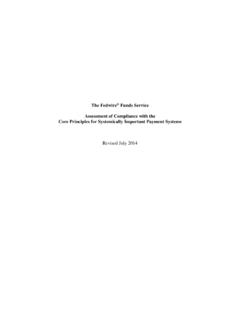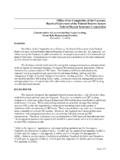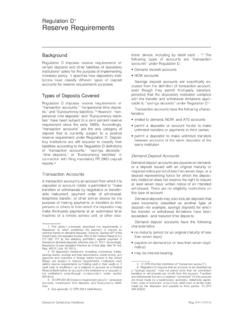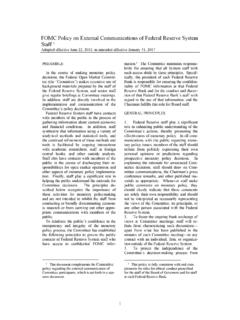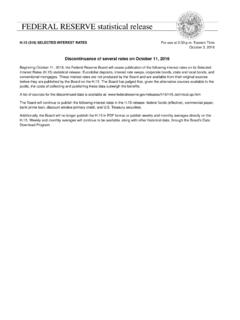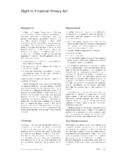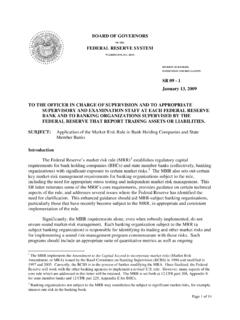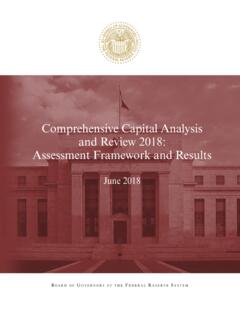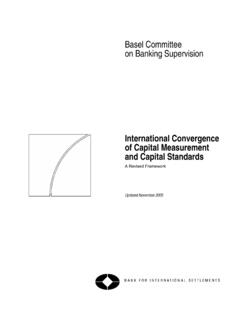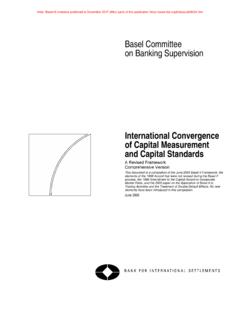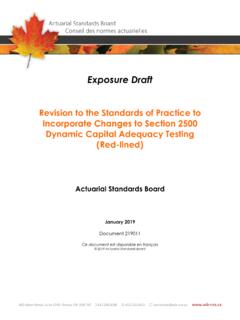Transcription of Comprehensive Capital Analysis and Review 2019 Summary ...
1 Comprehensive Capital Analysisand Review 2019 Summary InstructionsMarch 2019BO A R D O F GO V E R N O R S O F T H E FE D E R A L RE S E R V E SY S T E MComprehensive Capital Analysisand Review 2019 Summary InstructionsMarch 2019BO A R D O F GO V E R N O R S O F T H E FE D E R A L RE S E R V E SY S T E MThis and other Federal Reserve Board reports and publications are available online order copies of Federal Reserve Board publications offered in print,see the Board s Publication Order Form ( )or contact:Printing and FulfillmentMail Stop K1-120 Board of Governors of the Federal Reserve SystemWashington, DC 20551(ph) 202-452-3245(fax) 202-728-5886(email) .. 1 About this Publication .. 1 Differences between the CCAR 2019 Instructions and the Previous Year s Instructions .. 2 Overview of CCAR Process .. 3 Communications Related to CCAR and DFAST.
2 4 Mandatory Elements of a Capital Plan .. 5 Assessment of the Expected Uses and Sources of Capital .. 5 Description of All Capital Actions Assumed over the Planning Horizon .. 8 Description of a Firm s Process for Assessing Capital adequacy .. 10 Expected Changes to Business Plans Affecting Capital adequacy or Funding .. 11 Organizing Capital Plan Submissions .. 11 Data Supporting a Capital Plan Submission .. 11 Federal Reserve s Assessment of a Firm s Capital Plan .. 13 Qualitative Assessments .. 13 Quantitative Assessments .. 14 Federal Reserve s Responses to Planned Capital Actions .. 16 Disclosure of Supervisory Assessments .. 17 Resubmissions .. 17 Execution of Capital Plan and Requests for Additional Distributions .. 17 Appendix A: Templates for Comprehensive Capital Analysis andReview Results 2019 .. 19 Appendix B: Templates for Dodd-Frank Act Stress Testing Results2019.
3 23 Appendix C: Organizing Capital Plan Submissions .. 27 Capital Plan Narrative .. 28 Capital Plan and FR Y-14A Supporting Documentation .. 29iiiContentsIntroductionThe Federal Reserve s annual Comprehensive CapitalAnalysis and Review (CCAR) is an intensive assess - ment of the Capital adequacy of the largest holding companies (BHCs) and intermedi-ate holding companies of foreign banking organiza-tions (IHCs) (collectively, firms) and of the practicesthat these firms use to assess their Capital includes qualitative and quantitative assess -ments of firms Capital plans. The quantitativeassessment is based on the supervisory andcompany-run stress tests that are conducted underthe Board s rules implementing sections165(i)(1) and (2) of the Dodd-Frank Wall StreetReform and Consumer Protection Act (DFAST), asamended by the Economic Growth, RegulatoryRelief, and Consumer Protection Act (EGRRCPA).
4 2 The Federal Reserve expects the firms to have suffi-cient Capital to withstand a severely adverse operat-ing environment and continue to be able to lend tohouseholds and businesses, maintain operations andready access to funding, and meet obligations tocreditors and instructions include information about theFederal Reserve s qualitative and quantitative assess -ments of Capital plans submitted in connection withthis year s CCAR exercise (CCAR 2019) by (1) firmssubject to the Large Institution Supervision Coordi-nation Committee framework (LISCC firms) and(2) large and complex As described more onpage 3 below, large and noncomplex firms are nolonger subject to the qualitative assessment, and forCCAR 2019, certain of those firms are not subject tothe quantitative this PublicationThese instructions provide information regardingrequirements and expectations for CCAR 2019, thestress testing and Capital planning cycle that beganon January 1, 2019.
5 Similar to the CCAR instruc-tions in previous years, the instructions for CCAR2019 provide information regarding: logistics for a firm s Capital plan submissions; expectations regarding the mandatory elements ofa Capital plan; the qualitative assessment of a firm s Capital plan; the quantitative assessment of a firm s post-stresscapital adequacy ; the Federal Reserve s response to a firm s capitalplan and planned Capital actions; the limited adjustments that a firm may make to itsplanned Capital actions; and public disclosures by the Federal Reserve at theend of the CCAR 12 CFR ( Capital plan rule), 12 (e)(2)(ii) (stating that an IHC must comply with12 CFR in the same manner as a BHC).2 Pub. L. No. 111-203, 124 Stat. 1376 (2010); 12 CFR part 252,subpart E; Pub. L. No. 115-174, 132 Stat. 1296 (2018). Asdescribed below, the CCAR post-stress Capital Analysis uses thesame data, models, and assumptions as supervisory stress test-ing conducted in accordance with the Dodd-Frank Act require-ments, except that the CCAR Analysis involves the firm splanned Capital actions in the BHC baseline scenario ratherthan the Capital actions assumptions that are required in thestress testing the Board s Capital plan rule (12 CFR ), large andcomplex firms are BHCs and IHCs that, as of December 31, 2018,(1) have $250 billion or more in total consolidated assets,(2) have average total nonbank assets of $75 billion or more, or(3) are global systemically important bank holding compa-nies.
6 LISCC and large and complex firms should consult theguidance in SR letter 15-18, Federal Reserve SupervisoryAssessment of Capital Planning and Positions for LISCCF irms and Large and Complex Firms, December 18, 2015, 1 Differences between the CCAR 2019 Instructions and the Previous Year sInstructionsThe CCAR 2019 instructions have been updatedfrom the CCAR 2018 instructions to reflect changesto certain regulatory and reporting requirements. Removal of CCAR s qualitative objection: Concur-rent with the publication of these instructions, theBoard adopted a final rule to eliminate the Board sauthority to object to Capital plans on qualitativegrounds for firms other than those recently subjectto CCAR that continue to exhibit material defi-ciencies in Capital By January 1, 2021,the Board s authority to object to Capital plans onqualitative grounds will be eliminated entirely,other than for firms receiving a qualitative objec-tion in 2020.
7 Large and noncomplex firms exempted fromCCAR s quantitative assessment in 2019: Certainfirms with between $100 and $250 billion in assetswill not be subject to the company-run and super-visory stress testing requirements for 2019. Addi-tionally, while these firms remain subject to capitalplanning requirements, they are not required tosubmit their Capital plans to the Federal Reserve in2019. These firms will be subject to supervisorystress testing and Capital plan submission require-ments in Certain IHCs become subject to the global marketshock and counterparty default scenario: In Decem-ber 2017, the Board modified the scope of theglobal market shock component of the supervisorystress test to apply to a firm that has aggregatetrading assets and liabilities of $50 billion or more,or equal to or greater than 10 percent of total con-solidated As a result of this modification,IHCs that exceeded this threshold as of Decem-ber 31, 2018, became subject to the global marketshock for CCAR 2019.
8 IHCs are also now subjectto the counterparty default scenario. (See Coun-terparty Default Scenario Component for moreinformation.) Reduced supporting documentation: In an effort toreduce burden associated with the submission ofsupporting documentation, firms will only berequired to submit documentation related to thoseelements in scope for this year s exercise, asreflected in a scoping letter sent to each firm inDecember 2018. (See Organizing Capital PlanSubmissions. )CCAR and Changes in AccountingStandardsThe Financial Accounting Standards Board (FASB)periodically makes revisions to GenerallyAccepted Accounting Principles ( GAAP).These changes affect a firm s financial reportingupon adoption by the firm. The FASB made majorrevisions to accounting standards associated withrecognition and measurement of financial instru-ments, revenue recognition, leases, credit losses, andderivatives and hedging.
9 The effective dates for thesestandards range from fiscal years beginning afterDecember 15, 2017, to fiscal years beginning afterDecember 15, was the case last year, for CCAR 2019 a firmshould not reflect the adoption of new accountingstandards in its projections unless the firm hasalready adopted the accounting standard for finan-cial reporting purposes. If a firm was required toadopt or had voluntarily adopted a standard or aparticular provision of a standard as of Decem-ber 31, 2018, that adoption should be reflected in theFR Y-14A report with December 31, 2018, as-ofdates, and in the subsequent projected regard to Accounting Standards UpdateNo. 2016-13, Financial Instruments Credit Losses(Topic 326): Measurement of Credit Losses onFinancial Instruments (CECL), firms should excludethe potential effect of CECL from company-runstress testing projections for CCAR 2019, even if a4In CCAR 2019, Barclays US LLC, Credit Suisse Holdings(USA), DB USA Corporation, TD Group US Holdings LLC,and UBS Americas Holdings LLC are subject to the Board of Governors of the Federal Reserve System, Fed-eral Reserve Board releases scenarios for 2019 ComprehensiveCapital Analysis and Review (CCAR) and Dodd-Frank Actstress test exercises, press release, February 5, 2019, 6 See 82 FR 59608 (December 15, 2017).
10 7 The leases standard (Topic 842) was effective for annual andinterim periods beginning after December 15, 2018. The creditlosses standard (Topic 326) is effective for fiscal years beginningafter December 15, 2019, for Securities and Exchange Commis-sion (SEC) filers and after December 15, 2020, for non-SEC fil-ers. The derivatives and hedging standard (Topic 815) was effec-tive for fiscal years beginning after December 15, 2018, for pub-lic business entities (PBE) and after December 15, 2019, CCAR 2019 Instructionsfirm chooses to early adopt CECL for financialreporting purposes in of CCAR ProcessThe Board s Capital plan rule requires top-tier BHCsand IHCs subject to the Capital plan rule to submit acapital plan to the Federal Reserve Underthe Capital plan rule, a firm s Capital plan mustinclude a detailed description of the firm s internalprocesses for assessing Capital adequacy ; the boardof directors approved policies governing capitalactions; and the firm s planned Capital actions over anine-quarter planning horizon.
